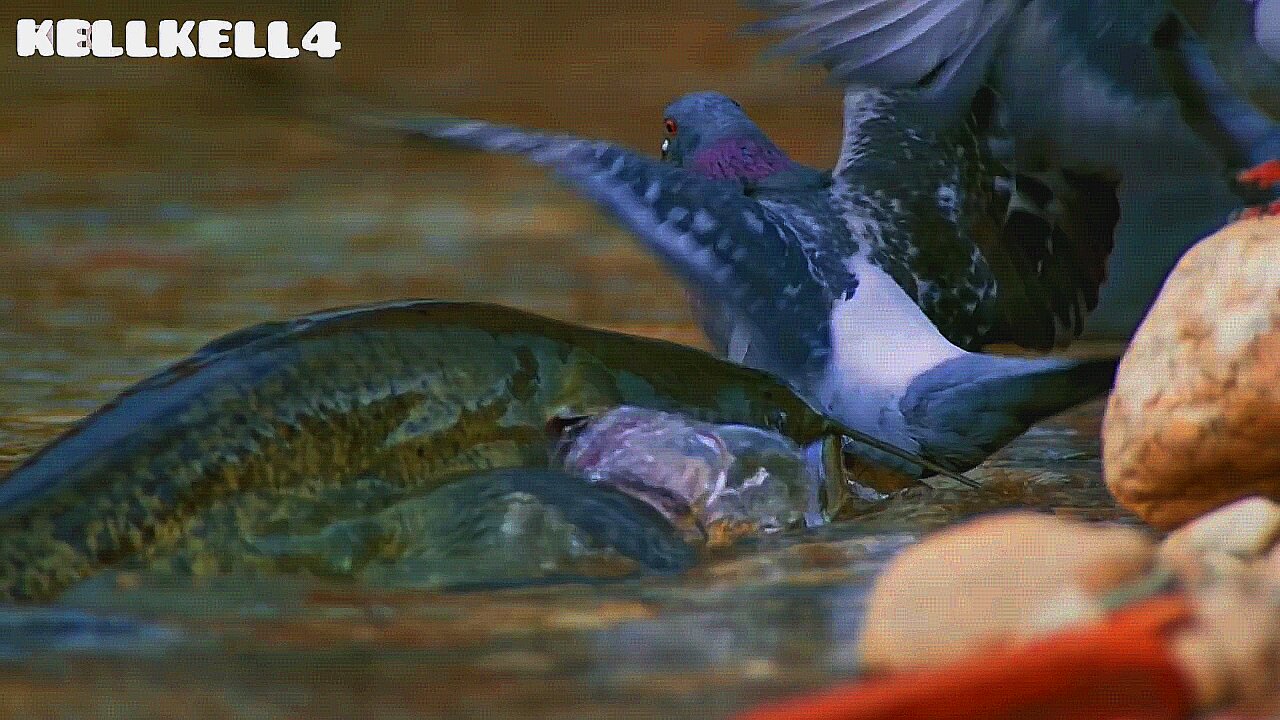Premium Only Content

Catfish attacks Pigeon at the water's edge
The Pigeons come to the water's edge to bathe and clean their feathers. The Catfish detects the oils in the water that comes from the birds while bathing and makes it's way upstream towards them. Then the Catfish launches an attack, which catches the Pigeon off-guard. The pigeon tries to get free from the Catfish clutch that held its feet. The Catfish then gives a death roll in the water drowning the Pigeon before it can eat it.
Catfish (order Siluriformes) is one of the largest orders of teleosts containing ∼4100 species, representing ∼12% of all teleosts and ∼6.3% of all vertebrates (Eschmeyer and Fong, 2014; Wilson and Reeder, 2005). Most catfish have a cylindrical body with a flattened ventral to allow for benthic feeding (Bruton, 1996). Catfish are so-named because of their whisker-like barbels, which are located on the nose, each side of the mouth, and on the chin. Most catfish possess leading spines in their dorsal and pectoral fins. Catfish are scaleless, a characteristic of catfishes distinguishing them from most other teleost fish. However, some catfish, such as plecos, possess bony dermal plates covering their skin (Arce et al., 2013; Armbruster, 2004; Burgess, 1989; Ferraris and Vari, 2012).
Catfish are highly diverse and distributed worldwide. They are commonly found in inland or coastal waters of all continents, including Antartica where fossils are found (Grande and Eastman, 1986). Catfish are most abundantly distributed in the tropics of South America, Africa and Asia, with one family native to North America and one family in Europe (Lundberg and Friel, 2003). Due to their worldwide distribution and diversity, catfish are interesting models to ecologists and evolutionary biologists, and are important for biogeographical studies (Sullivan et al., 2006).
Over half of all catfish species live in the Americas, of which channel catfish, blue catfish, and flathead catfish are the three primary catfish species in the United States. Populations of at least one of these catfish species are available in large numbers in most rivers, lakes, and reservoirs across the United States. Channel catfish are primarily native to the Mississippi River Valley but are widely introduced throughout the nation (FAO, 2015). Blue catfish are native to the Mississippi, Missouri, and Ohio River basins of central and southern United States, and also occupy south along the Gulf coast to Belize and Guatamala (Graham, 1999). Flathead Catfish (Pylodictis olivaris) are a large species in the Ictaluridae family. They spread primarily from the lower Great Lakes through the Mississippi River watershed to the Gulf States.
Catfish are quite hardy such that they are more adaptable for artificial spawning, handling, and culture. They possess all the characteristics necessary for aquaculture including relatively high fecundity, ability for artificial spawning, adaptability to earthen ponds for culture, high tolerance to low dissolved oxygen, relatively high resistance against infectious diseases, and relatively high feed conversion efficiency. It is such characteristics that make catfish one of the most popular groups of fish for aquaculture. In the world, a few major species are widely used for aquaculture, including channel catfish, blue catfish, walking catfish, shark catfish, Thai catfish, and African catfish. Channel catfish (Ictalurus punctatus) is the major aquaculture species in the United States. A closely related species, blue catfish (I. furcatus), is also important in this industry as the F1 hybrid catfish produced by mating channel catfish females with blue catfish males are now broadly cultured.
Catfish are of considerable economic importance for aquaculture and recreational fisheries. Its global importance is increasing as several countries in Asia, such as China and Vietnam, are now heavily involved in catfish aquaculture (Liu, 2008). Catfish are the primary aquaculture species in the United States, accounting for over 60% of all US aquaculture production (Liu, 2011). In the southeastern United States, particularly in the states of Mississippi, Kansas, and Alabama, catfish is one of the top agricultural commodities. The catfish industry provides employment opportunities for tens of thousands of producers, processors, services providers, marketers, retailers, and restaurant owners.
Catfish production in the United States mainly includes channel catfish, blue catfish, and their F1 hybrid. The market for channel catfish is well developed in the United States. In 2006, the catfish production reached 700 million pounds, becoming one of the fastest growing sectors in American agribusiness. Blue catfish is also important because of its ability to produce hybrid catfish with channel catfish. The F1 hybrid catfish produced by crossing channel catfish female with blue catfish male exhibit a high level of heterosis and is a preferred genotype for aquaculture. Artificial fertilization is required for the production of the interspecific hybrids due to reproduction isolation. Major progress has been made in recent years for efficient production of the hybrid catfish, which account for almost half of catfish fry used in the current catfish industry (Dr Rex Dunham, Auburn University, personal communications).
However, the catfish industry in the United States has recently encountered unprecedented challenges due to devastating diseases, high feed and energy costs, and fierce international competition. As a consequence, the catfish industry has significantly shrunk from its high in 2003 with 662 million pounds down to 334 million pounds in 2013 (Hanson and Sites, 2014). Many catfish producers are not profitable due to the high feed and energy costs, and the economic losses caused by the outbreaks of devastating infectious diseases. Therefore, genetically enhanced brood stocks are much needed to support the catfish industry.
The interspecific hybrid catfish produced by mating channel catfish female with blue catfish male are superior to either parent in most production and performance traits. In comparison with its parents, the hybrid catfish grow faster, have a more aggressive feeding behavior, exhibit a greater feed conversion efficiency, are more resistant to major bacterial diseases, are easier to harvest, and provide a greater fillet yield. These improved production and performance traits make hybridization one of the most effective genetic improvement programs (Liu, 2008).
The hybrid catfish has the potential to revolutionize the catfish industry. However, the bottleneck exists in mass production of the hybrid seeds due to reproductive isolation between channel catfish and blue catfish. Artificial spawning must be conducted to produce the hybrid catfish fingerlings, while the rates of fertilization and hatching of the hybrid catfish are normally lower than those of channel catfish. Fortunately, recent progress in artificial spawning and fertilization has allowed improved fry production. Another important achievement has been made through use of different strains of channel catfish and blue catfish, which has produced genetically distinct Channel catfish X Blue catfish hybrids with even more superior production characteristics (Dunham and Masser, 2012).
Several performance and production traits are important for aquaculture, which include, but are not limited to, growth rate, feed conversion efficiency, disease resistance, processing yield, seinability, stress tolerance, and tolerance to low dissolved oxygen (Liu, 2011). Growth rate is a primary trait for aquaculture because fast growth would allow shorter culture period to reduce the energy and other related costs. Enhanced feed conversion efficiency could reduce feed costs and increase profit margins since feed cost accounts for up to 50% of all variable costs. Disease resistance is one of the most important traits because diseases cause major economic losses, up to one third of the industry every year. Two major devastating diseases include the enteric septicemia of catfish (ESC) caused by Edwardsiella ictaluri (Hawke, 1979) and the columnaris disease caused by Flavobacterium columnare. In addition, channel catfish virus disease, motile aeromonad septicemia caused by Aeromonas hydrophila and the “Ich” disease caused by protozoan parasite Ichthyophthirius multifiliis, can also cause significant economic losses. Processing yield is important because most catfish are processed into fillet for marketing. Seinability is an important trait because any fish that is left in the pond after seining can significantly reduce the feed conversion efficiency. Stress tolerance is important because stress of catfish can lead to the so-called red flesh disease, caused by high levels of stress during harvesting and transportation immediately before processing. Tolerance to low dissolved oxygen is important because it directly affects survival rates and the energy cost due to the use of aerators. Genetic factors contribute to controlling all these traits, though most of these traits are affected by the environment and environment × genotype interactions. Efficient methods of selection for improving these production and performance traits within breeding programs must be developed to provide technological advantages to our catfish producers to help them compete in the global marketplace (Liu, 2011).
If you like my content, please subscribe and share. Leave your comments in the description below.
-
 1:37
1:37
Expert Videos Magnetic Media
3 years agoDolphin kisses a little girl and brings her a gift
46544 -
 4:12
4:12
ACLV
3 years agoPigeon Toss,
40 -
 0:06
0:06
Designer60
3 years agoFlying pigeon
18 -
 20:05
20:05
BuckeyeBigfoot
4 years ago $0.04 earnedBigfoot Encounter - At the Water's Edge
4723 -
 0:03
0:03
PaulHart
3 years ago $0.01 earnedA crazy pigeon U.K
27 -
 1:00:26
1:00:26
The StoneZONE with Roger Stone
8 hours agoSHOCKING NEW TAPE PROVES LBJ KILLED JFK! | The StoneZONE w/ Roger Stone
57.7K24 -
 1:44:33
1:44:33
ObaTheGreat
10 hours agoCrypto vs The World w/ Oba The Great And YaBoySkey
43.8K4 -
 4:39:55
4:39:55
VOPUSARADIO
2 days agoPOLITI-SHOCK! "COUNTDOWN TO TRUMP" & THE GLOBALISTS BURNING IT ALL DOWN..LITERALLY!
18.7K1 -
 44:34
44:34
Kimberly Guilfoyle
13 hours agoCountdown to Inauguration Day, Plus California in Crisis, Live with Joel Pollack & Roger Stone | Ep. 189
132K57 -
 1:32:41
1:32:41
Redacted News
12 hours agoBiden's 'SNEAKY' plot to slow down Trump REVEALED | Redacted w Clayton Morris
146K243